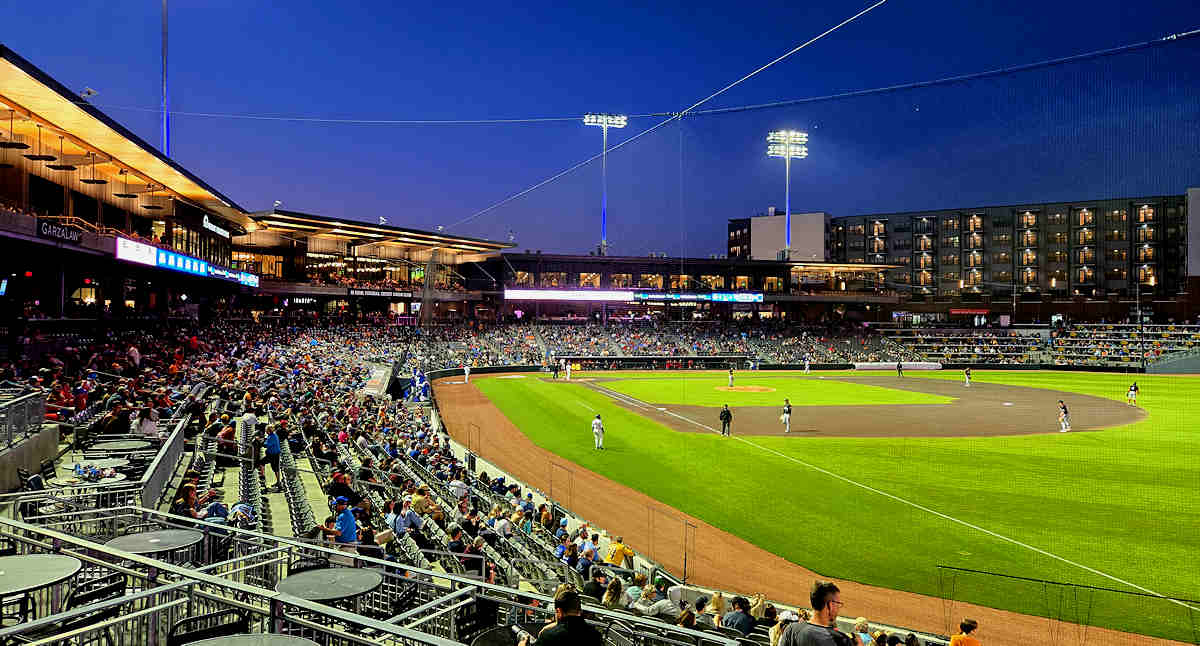
Article and photos by Joe Mock, BaseballParks.com
All rights reserved
KNOXVILLE, Tennessee Can a baseball stadium move?
In the case of the home field of the Smokies of the Double-A Southern League, the answer is yes. And with it even comes a change in the team name.
| Ballpark Stats |
 |
| Team: Knoxville Smokies of the Double-A Southern League |
| First game: April 15, 2025, a 5-4 win over Chattanooga |
| Capacity: 7,500, with 6,355 fixed seats |
| Dimensions: LF – 325; LCF – 375; CF – 400; RCF – 367; RF – 335 |
| Architects: Populous (Project team: Bruce Miller, Jason Michael Ford, Zach Allee, Brian Simpson, Peter Lang, Justin Cox), BarberMcMurry Architects, Design Innovations Architects |
| Construction: Denark and Barton Malow |
| Price: $116 million, paid by City of Knoxville, Knox County and Boyd Sports |
| Home dugout: 1B side |
| Field points: southeast |
| Playing surface: natural (Latitude 36 Bermuda) |
| Naming rights: Covenant, a not-for-profit health system |
| Ticket info: Smokies website |
| Betcha didn’t know: To prevent leaping outfielders from tumbling over the outfield wall into First Creek, the fence in right-centerfield is 10 feet tall. |
Here’s what all of this means. The Tennessee Smokies have played the last quarter century at Smokies Stadium in Kodak, Tennessee, between the city of Knoxville and the entrance to The Great Smoky Mountains National Park. That baseball facility was always referred to as America’s Friendliest Ballpark.
Now that the team has moved 20 miles west to a brand-new stadium in downtown Knoxville, there are 8″ high letters on its shiny new exterior that also welcome you to “AMERICA’S FRIENDLIEST BALLPARK.”
And with the change of address comes a new geographic team name, as “Knoxville” has replaced “Tennessee” before the nickname “Smokies.”
Too many changes for one offseason? “No, we moved the phrase ‘America’s Friendliest Ballpark’ to here because we are still the friendliest,” remarked Chris Allen, president and COO of Boyd Sports, which owns the team.
This is a franchise with very deep roots in this part of Tennessee. In 1954, the local minor league team moved into a ballpark called Knoxville Municipal Stadium, built along First Creek northeast of the city’s downtown. The Knoxville Smokies played in the Class B Tri-State League at the time. In 1956, Earl Weaver managed the team in the Class A South Atlantic League.
A year later, the ballpark’s name changed to Bill Meyer Stadium, the name it retained until the Smokies played their final season there in 1999. By that point, that part of town had become a rougher, more industrial area, not the nice neighborhoods of generations gone by.
The stately venue was demolished in 2003 and in its place aluminum bleachers were erected around the playing field. It adopted a new name that it still uses today: Ridley/Helton Field. The “Helton” is Todd Helton, the quarterback and first-baseman for the University of Tennessee Volunteers’ football and baseball teams. In 1995, Helton was named the Collegiate Baseball Player of the Year, and as you no doubt know, he was inducted into Cooperstown after a 17 year career with the Colorado Rockies.
When I visited Ridley/Helton Field while in town to see the new Smokies stadium, there was no historical marker to memorialize the rich baseball history on this site, nor was there even a sign with the current name of the park. What I did find there was a junior college baseball game.
In order to get to the field’s parking lot, you must drive over a small bridge that crosses First Creek. Exactly six-tenths of a mile downstream from this spot, this creek winds lazily across the berm beyond the outfield of new Covenant Health Park. More on the engineering marvel of partially burying that creek later.
| We are still the friendliest |
 |
| Chris Allen, president and COO of Boyd Sports which owns the Smokies, was adamant about bringing the nickname America’s Friendliest Ballpark to the new venue. |
When the Smokies left Bill Meyer, they signed a 25-year lease to play in a brand-new stadium 20 miles due east. Smokies Park — later referred to as Smokies Stadium –was built in Kodak, by the interchange of Interstate 40 and State Highway 66. Travelers from coast to coast have trekked through this intersection, as 66 heads south directly to the tourist attractions in and around the National Park. Here you’ll find the towns of Pigeon Forge, famous for Dollywood (I’ve always wanted to ride all of the “mountain coasters” in that area. Maybe one day I’ll get to), and Gatlinburg.
So millions of tourists pass through this area, and that no doubt helped attendance at Smokies games. During the 25 seasons they played in Kodak, the team called themselves the Tennessee Smokies. They were a smash hit, as fans flocked to the ballpark built into the hillside. It would be a bad assumption to think that the franchise decided to move back to the city of Knoxville due to lagging attendance or poor facilities. No, fans loved it, so much so that it became natural to call the place America’s Friendliest Ballpark. I decided to attend one last game there in June 2024, and the place was packed and the enjoyment level of the fans was off the charts.
| To Kodak and back |
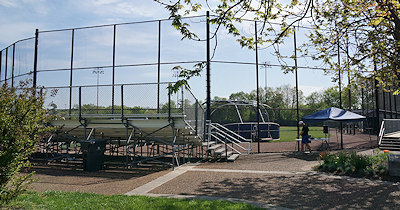 |
| After 45 years at Bill Meyer Stadium (how it looks today is above), the Smokies went 20 miles east for a successful 25-season run in Kodak (below). Now they are back in Knoxville. |
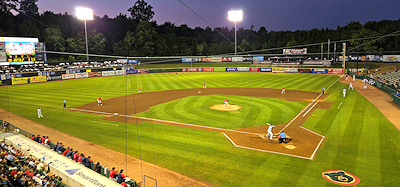 |
In fact, even during the last two seasons when fans were well aware that the team was moving back to Knoxville, the Smokies had the second highest attendance in the Southern League.
While they were playing to big crowds at Smokies Stadium, several very fortuitous events occurred.
In 2007, during the every-other-year juggling of affiliations between big-league and Minor League franchises, the Smokies ended a two-year run with the Diamondbacks and signed on with the Cubs. From a marketing, branding and merchandise standpoint, this was a match made in heaven.
Now the Smokies could work artwork of a bear (not to mention Cubs colors) into its branding — perfect for a team named the Smokies and perfect for a farm team of the Cubs. Merchandise flew off the shelves. Cubs legend Ryne Sandberg managed the Smokies in 2008.
And now the Cubs are the beneficiaries of having their young prospects developing in one of the most modern and spacious training facilities in the Minors. Everyone wins!
The second fortuitous event occurred in 2013. Jimmy Haslam, owner of the Cleveland Browns, sold the Smokies franchise to Knoxville-native Randy Boyd. Boyd was well-known in the state of Tennessee, as a local businessman (he developed the product today known as Invisible Fence to keep pets in their yards), president of the University of Tennessee statewide system and he even ran for governor of the state in 2018.
He founded the Boyd Sport Group which not only owns the Smokies but half the franchises in the Appalachian League, helping to keeping that once-struggling circuit afloat.
To further support sporting endeavors in Tennessee, he built Covenant Health Park so it can host games of the USL pro soccer team in town, One Knoxville Sporting Club — or One Knox SC for short.
And if he wasn’t already impressive enough, he’s run in marathons all over the world.
So now that his Smokies have settled into their new home, and are establishing that they still play in the country’s most friendly park, what is its neighborhood like? What about the architecture? What does it cost to go to a game there?
For all of this and more, keep reading our review!
The Setting
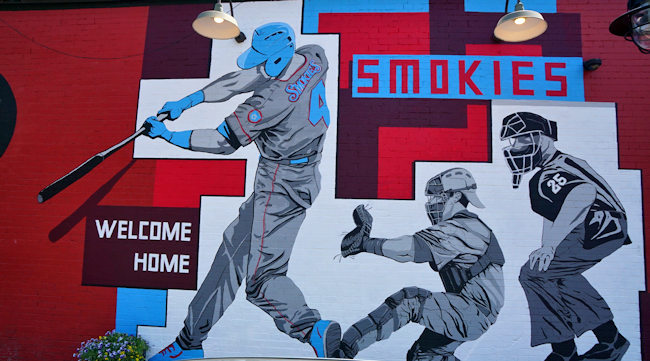
So why did the Smokies move away from a very successful run in Kodak. especially to the very neighborhood they abandoned a quarter century earlier?
Boyd realized that the Knoxville that the Smokies had left in 1999 had undergone quite a change. He told the Knoxville News Sentinel that “It’s becoming the next ‘it’ city, and people need places to gather and to play.” He had had acquired various properties around Knoxville, especially in the part of downtown called The Old City. When he bought the franchise, he could envision bringing it back to a brand-new facility, one that could be constructed where he owned land.
| ‘Revitalizing a neglected part of our city’ |
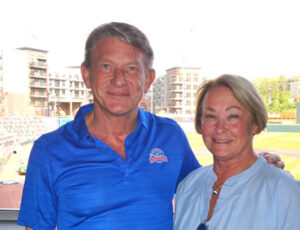 |
| Randy and Jenny Boyd, owners of the Smokies. Randy notes that the new park “gives us both a great sense of pride.” |
He told the newspaper that he had pride “not just bringing the Smokies back home to Knoxville, not just revitalizing a neglected part of our city, but we hope it will be a community gathering place where people from across the area come to have a great experience.”
While some might look at this as a shrewd, almost manipulative way to increase the value of the properties he’d bought around the new ballpark, I very much disagree. Boyd spent his money purchasing the team (the amount has never been made public, but one assumes it was more than $15 million, considering the following year, the Double-A Frisco RoughRiders sold for $32 million), and he’s entitled to select its location. He could’ve decided to re-sell it, perhaps doubling his money in just 12 years considering the skyrocketing valuations on Minor League teams now that the contraction of 2021 is behind us.
But he didn’t. He wants the team he grew up rooting for to play in the city where he was raised. And as we will see, the location Boyd selected is certainly a boon to that part of the city.
When I was given a tour of the construction site last June, my first reaction was, well, a little bit of horror because it is situated directly adjacent to a highway overpass. I mean, what team does that? It was also surrounded by run-down and apparently abandoned warehouses.
I wasn’t impressed.
Now that the park is finished, and the condos and apartments flanking it are nearing completion, I am realizing the brilliance of this location.
First of all, the overpass that I was viewing as a very bad structure to have so close to a ballpark actually gives the signage of the park unbelievable visibility on a busy roadway (James White Parkway). Further, Jackson Avenue is the street that runs under the overpass (below) and directly beside the front of the ballpark, connecting the northeast end of the Old City to the park and all of the new development that is currently under construction or in the planning stage.
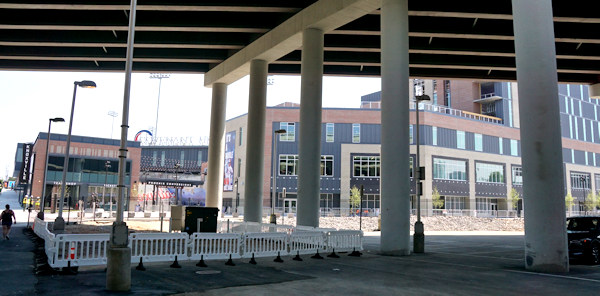
Some metropolises, especially in the South, are fortunate enough to have an area like Knoxville’s Old City. Austin has its Warehouse District with phenomenal, high-end restaurants tucked in reimagined old commercial buildings. Nashville has the honkytonks and trendy new bars on Lower Broadway. Atlanta has upscale Buckhead. Tampa has vibrant Ybor City. New Orleans has them all over the city. So why shouldn’t the emerging Southeast destination of Knoxville have one?
All of these neighborhoods have their own charm, their own architecture, their own murals and their own eclectic selection of eateries, and the Old City has one of the most appealing collection of all those things I’ve ever visited. In fact, the mural at the top of this section is on Jackson Avenue near Central Street in the Old City.

Within a 10-minute walk of the ballpark, there are at least a dozen bars and restaurants, all of them with their own approach to dining. My favorite was Southern Grit at 126 South Central Street. As its name suggests, Southern comfort food is what’s on the menu, like meatloaf, fried chicken, crabcakes and shrimp and grits. I elected the beer-battered shrimp, with phenomenal grits and delicious, creamy collard greens (above). And it serves a special beer that we’ll talk about in The Essentials part of this review.
 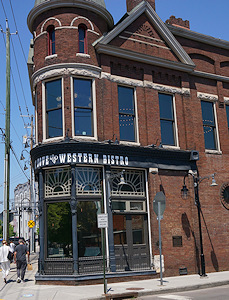 |
Another popular eatery is Boyd’s Jig & Reel (above left), owned by Randy’s wife Jenny. It’s a Scottish pub with an impressive assortment of whiskeys. Also check out Lonesome Dove Western Bistro (above right), which has mesmerizing exterior architecture and a gorgeous, ornate bar inside. These two establishments are caddy-corner from each other at the intersection of Central and Jackson, three blocks from the ballpark.
Possibly the closest Old City restaurant to Covenant Health Park is Barley’s Taproom and Pizzeria, on Jackson just on the other side of the overpass from the ballpark. Owned by Randy Boyd’s sons Thomas and Harrison, this is the same delicious pizza served inside the ballpark, but you have more selection of toppings and styles at the restaurant — plus Barley’s features live music.
Expect much more development coming to the Old City, including a hotel. Thanks to the arrival of the ballpark, one developer estimates there will be $500 million worth of redevelopment in this immediate area in the next decade.
Until there is further commercial development east of the ballpark, the Old City just to the west is where you will find most of the parking. Honestly, why not park in this area, have a wonderful dinner and walk to the ballpark for the game?
If you attend a game in 2025, you’ll find a lot of not-so-attractive warehouse-looking structures to the north and east of the ballpark, dubbed the Magnolia Warehouse District. Don’t worry, a good number of new businesses are expected to move into these sites in the next couple of years.
The Exterior
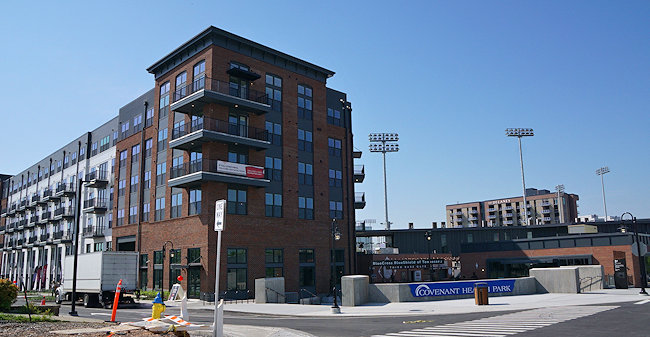
While not technically part of the ballpark itself, The Delaney condos on the east side of the park and the Yardley Flats apartments on the west look like they are attached, so let’s talk about them as part of the exterior of the park.
Boyd told me that when he started thinking about a new ballpark, he had Wrigley Field in mind. In particular, he loved the idea of the tenement buildings beyond the outfield, but he wanted apartments and condos in Knoxville to be integrated more into the park, to the extent that their living spaces would be directly above the park’s infrastructure. That would mean building up from the concession stands, restrooms, etc.
Builders advised him that such an arrangement wasn’t feasible because of the massive support system that would have to be integrated into the ballpark’s structures if multiple floors of living units were going to be built directly overhead. So he decided to do the next best thing and position the condos and apartments just barely outside the footprint of the ballpark.
They are turning out really well.
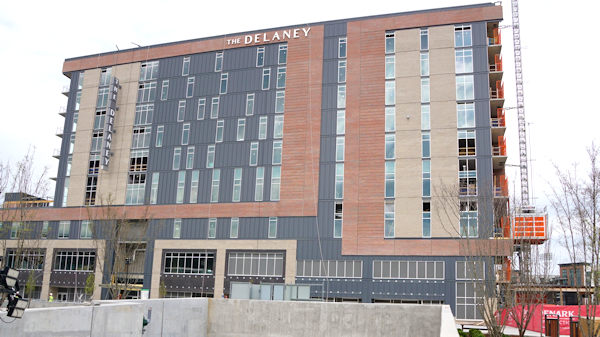
The condos (shown above from the exterior, not from inside the ballpark) are gorgeous, and they should be because prices range from $600,000 to $2.3 million. If you live in one, you’ll feel like you’re part of the action on the field, because you’re that close. The team offices are actually in the condo building, on the level of the main concourse of the park. The floor above that will be more office space, and above that are six levels with 47 luxury condos. Jenny and Randy Boyd own the building, which is named for Beauford Delaney, an internationally important artist whose boyhood home near the site of the ballpark was destroyed half a century ago for urban renewal.
The apartments on the left-field side of the park (below) look even more like they are part of the baseball facility, as they seem to wrap around the left-field corner. While they remind me of the apartments beyond the left fields in North August and Nashville, the ones in Knoxville are simply stunningly beautiful. And the rents are up there — with the smallest studio that doesn’t face the ballpark starting at $1,600 a month, and two-bedroom apartments facing the park going for $3,800.
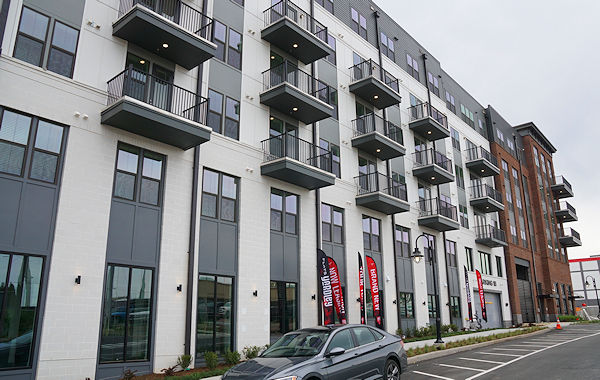
Note that you can see a pool from the concourse of the ballpark, but that is for the apartments, not fans at the games.
As you look at these pictures of the ballpark’s exterior, keep in mind that the condos, apartments and ballpark were not designed by the same architects — but there was great collaboration between the designers. “From the beginning, our team envisioned the adjacent mixed-used buildings and ballpark as one cohesive design,” said Brian Simpson of Populous, the architects for the ballpark. “Cues were taken from the Old City and the Magnolia Warehouse District in terms of materiality, scale and how the facades create manageable proportions. This set the criteria and rules early in the design process to ensure that even though different developers and builders completed the final designs of The Delaney and Yardley Flats buildings, the entire site would feel connected.”
Somewhat reminiscent of the Pensacola Blue Wahoos’ stadium, the park was designed with space for a row of restaurants embedded on the street level right along Jackson Avenue.
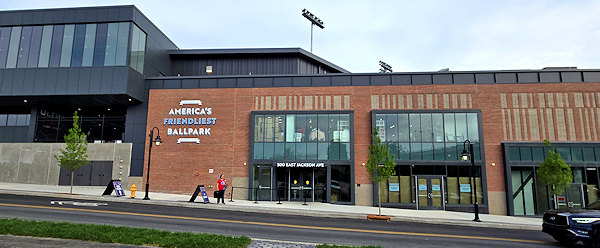
And in looking at this stretch of the exterior along Jackson (above), it is striking how uneven this parcel of land is. Jackson Avenue basically runs downhill from the entry plaza behind third base to the plaza behind first base. When you enter the park using the latter gates, you have to walk up the equivalent of two flights of stairs to reach the main concourse. When you enter behind third base, you are on the main concourse.
And all of this uneven-ness is after 35,000 tons of soil had been removed from the site before construction could begin in earnest.
As the ballpark opened in April 2025, two of the main entry plazas were finished — and they are both fantastic. The third, called the Elm Hill Gate beyond right field was nearing completion — but I don’t know how much need there will be for it. But it will look awesome.
I assume the main entrance to the park is considered to be the one behind first base. On ground level are ticket windows and a merchandise store, although there is a completely separate store up on the main concourse within the ballpark. In a perfect world, there would be one great big store with entry points both from within the ballpark and from the outside world when no game is going on, but I think the significant difference in elevation from the east side of the site down to the west side rendered that impossible. The rebuilt Columbus, Georgia park has just one store right by the entry gates that services both fans within the park and those outside the gates, but that is on a very flat piece of land.
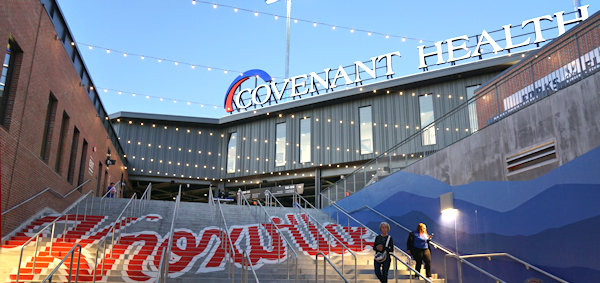
The first-base entry is really something to see (above). There is a large plaza at the corner of Jackson and Patton Street (now renamed Stadium Way), certainly large enough to stage a community event. After passing through the metal detectors, the grand staircase is stunning, with Knoxville spelled out in the risers for each step. “The entry steps and branding remind me of Petco Park in San Diego,” noted Populous’ Jason Michael Ford, referring to another park designed by his firm. “The difference here is that when you get to the concourse you have views of the field.”
While the third-base entry plaza isn’t as large, it is a spot you should definitely visit (below left). Here are statues of former Negro League Players including those from the Knoxville Giants who played in the Negro Southern League. Among them was one of the most fascinating players of the era: Forrest “One Wing” Maddox (below right), who lost his left arm in an accident when he was a child. He figured out how to bat and play the outfield, and became a sensation in Negro League circles.
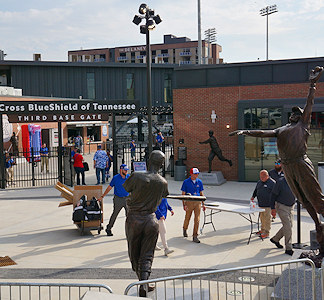 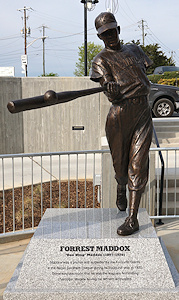 |
Keep reading, as we venture inside Covenant Health Park for a look at the interior.